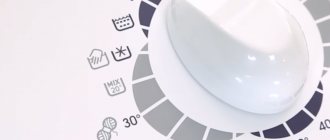Not all symbols are present on a computer keyboard. There is no diameter symbol on it either. The generally accepted designation for diameter is as follows - “Ø”. But there are many ways to insert it in many different applications. The most popular among them is the use of ASCII codes. The second method is associated with the Microsoft office suite and only works there. The third method is to use the clipboard. To execute it, you need the diameter icon itself, which will be inserted into the desired application using the “copy” and “paste” function.
All methods will be discussed in detail and presented in this article.
What do the washing symbols on clothes and linen mean?
Each of us, when buying something we like, wants it to not lose its attractive appearance for as long as possible. This is possible provided you take proper care of it. Washing symbols on clothes will tell you how, for example, not to turn your favorite sweater into a car seat cover when washing. Any decent company places such badges on a control tape sewn onto the clothes from the wrong side in the collar or waist area. It turns out that it exists not only to quickly figure out where the front of clothes is and where the back is! Most of these icons do not require decoding, but some cannot be understood without prior preparation. Let's try to figure it out?
Punishments
So you and I have studied the sign prohibiting parking. In general, there are many more additional clarifying symbols that specify the action of it. But the most popular of them are now no secret to us.
Violating parking and stopping rules can result in punishment. It will not always be serious, but this feature will have to be taken into account. And, as practice shows, special attention is paid to places specially equipped for parking.
The nature of punishments varies. Firstly, it all depends on the region where you live. If you live in a federal area, it will be stricter. And in ordinary cities it’s softer. Secondly, your history of “relations with the law” will also play a certain role in case of a particular violation. And this is a pretty important factor. Thirdly, a lot depends on the situation as a whole.
Getting to know the symbols for washing
Different manufacturers may use slightly different labels. But, knowing the basic symbols, every housewife can easily decipher similar icons and their meaning.
An inverted trapezoid with a horizontal wavy line inside the figure - this icon carries very useful information on how to properly wash an item and not spoil its presentation. This icon also looks very much like a bowl filled with water. It is taken as a basis and outlined with various figures that carry prohibitions or permissions during washing.
| Crossed out icon – cannot be erased. |
| The familiar inverted trapezoid with a hand inside - hand wash only. |
| A symbol without any additional figures - the item is subject to both hand and machine washing. |
| The symbol underlined by one line means use a gentle wash cycle and low spin. |
| Symbol underlined by a dotted or double line – use the delicate wash program. You can't squeeze with your hands |
| There are various numbers on the label - use a water temperature no higher than the specified one: 30, 40, 50, 60, 95. Sometimes temperature conditions are indicated by dots: 30° - one dot, 40° - two, and so on. |
| The icon indicates a temperature of 95° C - the clothes are subject to boiling, and when washing you do not need to be particularly careful. |
| A triangle on the label means the item can be bleached. |
| The crossed out triangle can most often be found on clothing made from colored fabrics. It means that the item cannot be bleached. |
Drying conventions
In order for clothes to delight their owners with their newness for a long time, they must not only be washed properly, but also dried. The international graphic symbol for drying is a square with various additional shapes. So, let's get acquainted.
| Empty square - the item can be dried in a machine. |
| Crossed out sign – do not tumble dry. |
| A horizontally rotated, sometimes crossed out, figure eight is drawn in the square - pressing is prohibited. |
| Circle in a square - allowed to wring in the washing machine and dry in a drum and electric dryer. |
| The sign with the circle is crossed out - do not wring it in the washing machine and dry it in a drum or electric dryer. |
| A circle in a square with a dot in the center - it is allowed to dry in a drum or in an electric dryer at a minimum temperature. |
| A circle in a square with two dots in the middle - it is allowed to dry in a drum or in an electric dryer at a hot temperature. |
| The circle in the square is underlined by one line - use a gentle drying mode. |
| The circle in the square is underlined with two dashes - select the delicate drying program. |
| A square with three vertical lines inside - dry without spinning. |
| An icon that looks like a pocket with a flap - dry in a vertical position after spinning. |
| A square with a horizontal line in the middle - use only horizontal drying. |
| The upper left corner of the square is crossed out diagonally with three lines - dry only in the shade. |
Follow these simple rules - and the symbols for washing and drying clothes will become your best advisers on how to keep your favorite things in great shape!
Odd days
There is also a sign prohibiting parking on odd days. And it doesn't look particularly original. It is somewhat reminiscent of a sign prohibiting parking on even days of the month.
What exactly does the next type of ban look like? This is nothing more than “No Parking”, but there is one “brick” in the center. In a vertical position and under the diagonal line of the circle. That is, it is crossed out. That's all.
The restrictions in this case are exactly the same as in the previous case - parking is prohibited to all citizens with the exception of the post office, minibuses (transport), as well as the disabled. You can park on even days. If there are any clarifications under the index, pay attention to them. It happens that on both even and odd days, parking is prohibited only at certain times. This is a fairly common phenomenon that drivers rarely pay attention to.
Diameter sign
In cases where it is necessary to indicate the diameter size, use a sign in the form of a circle with a line “Ø”. This symbol is placed before the size number.
Examples of using the diameter sign:
Diameter signs on cylindrical and conical rotating parts
Dimensions applied when there is not enough space on the dimension line
Designation of sizes when there is not enough space for arrows
Diameter is the length of a straight segment connecting the surface of a circle. The diameter segment, in any case, passes only through the center of the circle. It is usually designated by the Latin letter “D” or the sign “Ø”. If the radius of a circle is multiplied by two, the sum is the diameter. All volumetric bodies that have a spherical shape, as well as those where at least one of the possible sections is a circle, are designated by diameter symbols. The word “diameter” comes from the Greek word “diametros” - diameter.
An example of the designation of four holes indicating the diameter
On technical drawings, diameters are indicated by a symbol in the form of a crossed out circle “Ø”. This sign is placed in front of the dimensional numbers of parts, which can be either cylindrical or conical.
In cross-section, the cone is a right triangle, one of the legs of which is parallel or parallel to the body of rotation. Its parameters are designated as follows: “D” – larger diameter, “d” – smaller diameter, “L” – length. In the drawing, the diameters of the cone are indicated by numbers, preceded by the signs “Ø” and the numerical value of the length without letter designations.
The most common parts with cylindrical surfaces include shafts for various purposes. Cylindrical bodies formed by rotating a rectangle around one of its sides are designated by diameter. Smooth shafts have some design features and are divided into varieties: straight, stepped one-sided, stepped double-sided and heavy. For example, the shafts of asynchronous motors, in which the rotor is mated to the shaft by pressing to its largest diameter, and on both sides there are steps for bearings, fans, and pulleys. Double-sided stepped shafts can also be found in various mechanisms where any other design features are required. Cylindrical parts generally have a maximum overall length and an outer diameter. Depending on the specific configuration of a particular product, it may include elements such as internal and external grooves, steps, recesses, etc. with different diameters, the values of which are preceded by “Ø” signs.
An example of applying a diameter sign on a spherical surface
Parts with conical surfaces include tool adapter bushings, which have conical outer and inner surfaces. Such bushings provide high centering accuracy and quick tool changing with sufficient rigidity when used on machine tools. Adapter sleeves come in short and long versions.
Conical tool parts of this type are called " Morse taper " and are divided into numbers. The angles, lengths and diameters of adapter bushings can be taken from special tables. In the tabular data, letter designations are used such as – “d” is the smaller diameter, “D” is the larger diameter, “L” is the length of the part. In the drawings, diameters and lengths are indicated by digital values, and the sign “Ø” is placed before the diameter numbers.
“Morse taper” - in addition to adapter bushings, it is used in the manufacture of twist drill shanks, end mills, fixtures and mandrels. Tool cones are fixed due to elastic and plastic deformation. To implement such connections in the spindles of milling and lathes, conical holes are provided for installing auxiliary tools. In addition, on a lathe, the tailstock quill has the same conical hole.
In technology, a large number of parts and their elements are used to indicate which the diameter sign is used. For standard diameter sizes, a parametric series is used, which includes standard sizes. When developing technical products, the calculated diameters are rounded to their nearest values. When designated on technical drawings, the diameter sign must be accompanied by the axis designation with a dash-dotted line, which indicates a circular cross-section of the part section.
The emergence of standardization
Drawing allows you to create a graphic image of an object necessary for its manufacture. However, the appearance of a product alone is not enough for production. The drawing also contains the dimensions, scale, specifications, material and other characteristics of the part. Further development of production led to the division of labor, when components are manufactured at different enterprises, and then the finished product is assembled. This required the unification and standardization of parts and a single rule for the execution of drawings. For the convenience of recording and perceiving technical information, symbols were introduced, such as, for example, a sign for diameter or thickness, making it easier to record the indicated characteristics.
- Stop signs give way and roundabout signs.
- Speed limit signs do not have right turn signs.
- No parking signs are permitted parking signs.
Warning signs indicate a hazard that may not be obvious to an approaching driver. They are a diamond shape with a black legend or symbol on a yellow background to show caution. Speed warning signs alert traffic control devices to road conditions. Management signs keep motorists informed. Route directions and distances to destinations of interest and roadside objects. Noisy engine brakes are a common complaint. Truck noise warning signs remind truck drivers to avoid using their exhaust brakes around metropolitan and rural areas.
“No Parking” sign: features, coverage areas
The importance of knowing road signs cannot be underestimated, since they provide the driver with comprehensive information related to road traffic.
These information images indicate what is prohibited, what is allowed on a given section of the road, inform and warn the driver about the danger.
They are divided into nine groups:
- Warning. As the name suggests, the purpose of these types is to inform about dangers on a section of the road in order for the driver to take appropriate measures to ensure the safety of themselves, passengers and pedestrians.
- Priority signs. Indicate to drivers the order of passage through narrow road sections and intersections.
- Prohibiting. Appropriate traffic restrictions are introduced and also lifted.
- Prescriptive. Establish mandatory driving conditions on a lane or section of road.
- Special instructions. Designed to organize a certain traffic mode, or cancel it.
- Additional Information. These are signs used in conjunction with other types, complementing or clarifying the actions of the latter.
- Information types.
- Identification varieties.
- Service.
Below we will look in detail at the “No Parking” type, which is classified as prohibiting, so first we will take a closer look at this broad group.
Addition
Please note that very often there are some additional signs on poles with installed signs. They play an important role in traffic rules. Their task is to clarify certain points.
For example, a sign prohibiting truck parking is “No Stopping,” with an additional small picture of a truck underneath it. Please pay attention to this feature. After all, very often prohibition signs have certain clarifications. And, of course, the coverage area. Which one? We will talk about this now.
Prohibiting varieties
Outwardly, it is very simple to distinguish them - a circle with a red border on a white or blue background, which is quite difficult not to notice. This is a very large group that regulates literally all aspects of road traffic, starting from the maximum permissible speed, restrictions on the weight and types of vehicles, and ending with the ban on entry, parking and stopping of cars on various sections of the road.
It is important not only to confidently imagine what prohibitory signs look like and what exactly they prohibit, but also to understand exactly on which sections of the roadway they operate, that is, to imagine the area of effect of the sign. Let's first figure out where the zone of action of the prohibiting species begins.
Regarding the lanes to which it applies, everything is also quite simple - prohibitory signs only apply to one side of the road, where they are installed.
Of course, there are exceptions to any rule. So, for example, the “Parking is prohibited” type, established at the entrance to the yard, does not apply to persons living in the house or working in an organization located here, if a detour is not provided. There are other exceptions related to the action of this sign, which will be discussed below.
Sign No parking
This road symbol can be found very often - a blue circle with a red border, crossed diagonally by one red stripe. It is clear that it prohibits parking of vehicles on any day of the week.
But sometimes you can find it prohibiting parking, for example, only on odd days, or even days - on them one or two white stripes (vertical) are drawn inside a crossed out circle. Accordingly, one lane is crossed out - you cannot park a car only on odd days, two - on even days.
However, there are restrictions here too - the ban is valid only until the evening - until 19.00, so in order not to break the rules, before 21.00 the vehicle must be driven to the other side of the road - as a rule, a sign with a reverse restriction is installed on it.
Well, in the period from 19.00 to 21.00 you can park your car in the coverage area of any sign - you will not break the rules. It should also be noted that there are categories of people who can safely ignore the “Parking Prohibited” symbol.
We will not describe in detail the rules for federal postal vehicles, for which this type does not apply - this is not relevant for us. It is much more important that cars of disabled people of groups I and II and persons transporting such disabled people can park under this graphic element without fear.
No parking or stopping sign
This type, so to speak, is closely related to the road sign we described above. The fact is that where stopping is prohibited, parking is also prohibited, but not vice versa.
You can stop in a “No Parking” zone and you won’t be fined. Let's take a brief look at how a parking lot differs from a stop.
There are no difficulties here, since this issue is covered in some detail in the traffic rules. Understanding the differences between parking and stopping is very simple.
But if at the same time you perform actions related to boarding/disembarking passengers, loading/unloading a car, then regardless of how much time it takes you, you will make a stop, not a parking lot, even if it lasts at least 15 minutes, at least a whole hour.
Externally, “Parking and stopping is prohibited” is very similar to the prohibitory type we described above, only it is no longer one diagonal red stripe on a blue background, but two intersecting stripes.
It also applies only to its own lane. Exceptions to which this symbol does not apply include only route vehicles. Please note that disabled people in their vehicles can no longer stop in the coverage area of this element, unless, of course, a corresponding information sign is installed under it.
Area of operation of the “No parking” sign
In general, its coverage area is the same as that of other prohibitory images, that is, from the installation site to the first intersection, or to the end of the populated area, if no other symbols are installed that remove the restriction.
However, there are nuances:
- Firstly, the zone can be defined by a yellow broken marking line at the edge of the roadway: as long as it is there, parking is prohibited, and with the end of this line, the sign’s coverage area ends.
- Secondly, at the beginning of the article it was not for nothing that we briefly mentioned other road types, in particular, signs used in conjunction with other types to clarify the action of the latter.
Thus, the coverage area signs (vertical arrows on a white rectangle), located under the sign, precisely determine its coverage area.
Thus, if under the graphic element “Parking Prohibited” you see an arrow pointing down, this means the end of the sign’s coverage area - it will be possible to leave a vehicle behind it, unless, of course, other traffic rules are violated. If the sign indicates an arrow pointing upward, this means that the coverage area will begin from the location where the sign is installed, but you can also usually see a number indicating the length of the coverage area in meters.
The direction of movement to which the sign applies is also important. A regular blue circle crossed out with a red stripe, like any other prohibiting type, only applies to the side of the road where it is installed. At the same time, remember also about the “Parking Restricted Zone” view, which is a large white rectangle with a “No Parking” sign drawn inside it - it already applies to the entire roadway.
The parking ban is also canceled by the “End of all restrictions zone” pictogram - a white circle with black stripes crossing it out. By the way, there is a similar sign for the above-mentioned “Parking Restriction Zone”.
Penalty for parking a vehicle in a “No Parking” zone
The Code of Administrative Offenses states that ignoring requirements of this type provides for a fine of 1,500 rubles. And if the offense was committed in Moscow or St. Petersburg, then the fine will already amount to 3,000 rubles.
In addition, the car can easily be sent to a penalty area. In order to receive a fine for illegal stopping or parking, by the way, it is not at all necessary to stop in the area covered by the relevant signs.
If you happen to, for example, leave your car closer than five meters to a pedestrian crossing or on it itself, then you will be given the same fines.
Compatibility with other types
We mentioned above that “No parking” can be installed in conjunction with information signs.
They are divided into a couple of groups:
- Indicating the type of vehicle for which parking is prohibited. These can be motorcycles, trucks, trucks with trailers, route vehicles, etc.
- Coverage area signs. These are vertical arrows on a white background that can point up, down, or both ways. They indicate the direction of the zone in which the sign is valid. Sometimes the sign additionally indicates the distance of the coverage area in meters.
To protect yourself from monetary losses caused by exorbitant fines and costs of “rescuing” a car from a parking lot, do not neglect the parking rules determined by the corresponding information symbols on the road, markings, etc.
After all, failure to comply with these requirements can cause accidents on the road, numerous casualties, and simply create traffic jams that get on your nerves when driving through a densely populated city. Therefore, do not break the rules, leave your car in the parking lot only in permitted places.
Arrow to down
Clarifying signs very often indicate the coverage area of the main sign. And in our case, you can easily get confused. Please note that a no-parking sign with an arrow pointing down is quite common on roads. But what does he “represent”?
As practice shows (and the law states), this kind of image indicates the end of the sign’s validity. That is, you can already park behind it. And nothing will happen to you with such actions. But it’s better not to stop in front of the sign. After all, the coverage area has not ended yet. In principle, there is nothing difficult to understand. Did you see a down arrow under “Stopping prohibited” (in a separate sign)? Then know that you can park behind this sign. The restricted area is ending.
Wash
Washing is a group of signs that denotes all manipulations for washing clothes, starting from permission to wash, ending with temperature and mode. The main symbol in this group is a basin of water.
- A basin with water and the signature “machine wash”, or “mashine wash” - machine washable;
- A basin with water and one horizontal line at the bottom - it is allowed to wash, but carefully, without rubbing, squeezing or twisting;
- A basin with water and two horizontal lines at the bottom is the most gentle hand wash mode, with plenty of water. It completely eliminates spinning and friction, only light rinsing movements;
- A crossed out basin means a complete ban on washing, that is, you can immediately look at the instructions for dry cleaning, if any;
- The basin with the numbers 30, 40, 60, 90 indicates the temperature for washing clothes;
- A basin with water and a hand inside is a sign of hand washing.
Whitening or stain removal
This group of symbols on clothing indicates what type of bleach can be applied to the fabric, if applicable. The bleaching symbol is a triangle with and without inscriptions inside.
- The triangle is a sign that the item can be bleached;
- A triangle inside with the inscription CL means that the item can be bleached with products containing chlorine;
- A crossed out triangle is a sign prohibiting bleaching, both with and without chlorine. That is, things may lose color during bleaching.
Double arrow
But that is not all. Many drivers, especially beginners, can become confused by traffic signs. And in clarifying interpretations too. For example, what does a no-parking sign depict with an arrow down and an up arrow?
We have already dealt with one “arrow”. This is an action limitation. What about the double then? In this case, there is no need to panic. The only thing worth considering is that this kind of sign shows us that it is within the coverage area of the main sign. That is, it prohibits parking in a certain area before and after the pole. Nothing difficult. Typically on the same side you will see a “No Stopping” with a down arrow. These are very common cases. Therefore, there is no need to be afraid or afraid of the double arrow. It is needed to prevent stops in a certain area. Quite often there is a specific small clarifying symbol in the form of meters. It indicates the parking restriction area after and before the sign.
Dry cleaning
This group of symbols will be the most informative for dry cleaning service employees, as they indicate the types of chemical exposure to fabric. The symbol for dry cleaning icons is a circle and various letters inside it.
- Circle - means dry cleaning of clothes, that is, specialized dry cleaning of clothes;
- A circle with the letter “P” inside means permission to use conventional reagents, except trichlorethylene;
- A circle with the letter “P” inside and a horizontal line below - the same meaning as the previous point, but the cleaning conditions should be more gentle;
- Circle with the letter "F" inside - dictate the use of gentle, gentle solvents such as hydrocarbons and trichloromethane;
- A circle with the letter “A” inside - allows you to use any solvent, but with care;
- A crossed out circle means any dry cleaning is prohibited; no dry cleaner will undertake the work with this sign, as the result may be unexpected.
Even days
Another rather interesting case is the sign prohibiting parking on even days. It does not occur very often in small cities, but in large cities all the time. Moreover, it does not apply to taxis, fixed-route transport, or cars driven by disabled people. In all other cases you will have to follow the rules.
What does this sign look like? This is “No Parking”, but inside the circle there will be two white “bricks” located vertically. And they will be crossed out. As you can see, nothing supernatural either. If you see this sign, you can be sure that you cannot stop here on even days in the month. The rest of the time this rule does not apply. And each driver can “pause” in the area near the sign. This is worth taking into account.
Spin
This group of icons describes how clothes are spun during washing. The spin symbol is a circle inscribed in a square.
- A circle in a square means that the item can be pressed, that is, it will not lose its appearance and integrity during spinning, both manual and machine;
- A circle in a square with a horizontal line at the bottom - only manual or delicate machine pressing is possible;
- A circle in a square with two horizontal lines at the bottom - allows for the possibility of gentle manual spinning, the machine can damage the item with this icon;
- Circle in a square with one dot in the center - allows machine drying at low temperature;
- A circle in a square with two dots in the center - it is permissible to dry the item in a centrifuge at medium temperature, that is, in normal drying mode;
- A crossed out circle in a square means that a thing with this sign cannot be dried or squeezed.
Ø - Wikipedia
Material from Wikipedia - the free encyclopedia
| Latin letter O with diagonal stroke | |
| Øø | |
| Image | |
| Ø : latin capital letter o with stroke ø : latin small letter o with stroke | |
| Unicode | Ø : U+00D8 ø : U+00F8 |
| HTML code | Ø : or ø : or |
| UTF-16 | Ø : 0xD8 ø : 0xF8 |
| Ø : %C3%98 ø : %C3%B8 | |
| Mnemonics | Ø : Ø ø : ø |
Symbols with a similar style: ∅ · ⌀
Ø
,
ø
(
O with a diagonal stroke
) is an extended Latin letter used in the Danish, Norwegian and Faroese alphabets to represent the front rounded vowel of the mid-high rise. Also previously used in Uniphone for English[1].
For a more accurate phonetic transmission of French eu, German ö, Scandinavian ø (which do not imply softening of consonants), at the beginning of the 20th century, a transliteration option into Russian using the letter Ӭ was proposed.
Drying
This is the last group of designations that can be found on labels of clothes and things. The drying method depends on these icons - from natural to machine. The drying sign is a square.
- A square that looks like a postal envelope means the possibility of vertical drying, that is, on clotheslines, hangers and swing dryers;
- A square with three vertical lines inside - allows you to dry the item in a vertical position, but without squeezing it;
- A square with one horizontal stripe inside is a sign that allows only horizontal drying;
- A square with a triangle in the left corner means drying only in the shade, avoiding direct sunlight.
Time
And that's not all. Sometimes you can find quite non-standard parking restrictions on the streets. For example, a sign prohibiting parking, indicating the time. To be honest, everything is quite simple here. The driver does not have the right to stop near the sign and after it within a certain period of time.
Which one? This will be indicated by a clarifying sign below under the main image. Most often, such restrictions are imposed in busy areas of cities. And you must anticipate this. At times not indicated on the table, you can park in certain places. Although some drivers still do not risk doing this. Only in rare cases, when it is really necessary. It’s better to play it safe once again than to run into this or that punishment.
Ironing clothes
This group displays methods for ironing clothes. Sometimes this procedure will simply help to straighten the fabric after washing and drying, and sometimes it will help disinfect and additionally kill germs. The ironing symbol is an iron.
- Iron - it means that the item can be ironed; inside the iron there can be points from one to three, each of which corresponds to the heater scale in the iron, so this issue is very easy to deal with;
- An iron with a crossed out bowl below, or a crossed out cloud on top - this sign means that the item cannot be steamed or ironed with steam, as this process may fade its color;
- Crossed iron means ironing is prohibited.
Now you have an idea of all the signs that can be found on clothing. Be careful, and before cutting off the tag and throwing it in the trash, familiarize yourself with the care of the purchased clothing.
please tell me how to write a crossed out zero and if it’s difficult then just write it to me and I’ll copy it
You open the document... Select “Insert” (on the top panel) -> “Symbol” and select the desired symbol... Good luck.. . And here, to copy: Ø
There is a folder on your computer called TABLE OF SYMBOLS (look for it in Start)… maybe there’s a zero there too
Press the key combination windows + R (or run start) and write charmap And then you’ll figure out questions with your computer for the future, it’s better to ask here https://otvet.mail.ru/it/
In Word - insert\symbol, there are a lot of different symbols
Ø Is there a diameter that will work?
© ® œ ™ everything that is











